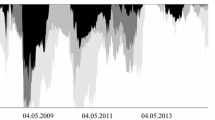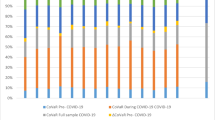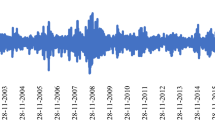Abstract
This study is unique in examining the spillover and leverage effect of Smart Beta Exchange Traded Funds (SB ETFs) and their underlying indices and Cap-Weighted (CW) indices. We find unidirectional return spillover from most SB ETFs to CW indices and bidirectional return spillover between SB ETFs and SB indices using VAR/VECM model. Besides, we find that information is transmitted faster from SB ETFs to the indices than from indices to SB ETFs. Interestingly, we observe that innovations in SB ETFs explain 97% of variance in SB indices and 81% of variance in CW indices. Hasbrouck’s information share of SB ETFs is highest (88%) followed by CW indices (5.6%). ARIMA-GARCH model shows that bidirectional volatility spillover exists between SB ETFs and the indices. ARIMA-EGARCH model provides evidence of leverage effect in SB ETFs, highlighting that volatility increases more after negative shocks than after positive shocks. Our study provides evidence of greater information transmission from SB ETFs to SB indices and to CW indices.
Similar content being viewed by others
Abbreviations
- ACF:
-
Autocorrelation function
- ADF:
-
Augmented Dickey Fuller
- AIA:
-
Adaptive investment approach
- AIC:
-
Akaike information criteria
- AMC:
-
Asset management companies
- AMFI:
-
Association of Mutual Funds in India
- AMH:
-
Adaptive market hypothesis
- ARCH:
-
Autoregressive conditional heteroscedasticity
- ARCH LM:
-
Autoregressive conditional heteroscedasticity Lagrange multiplier
- ARIMA:
-
Autoregressive integrated moving average
- AUM:
-
Assets under management
- BM CW index:
-
Benchmark cap-weighted index
- BM SB index:
-
Benchmark smart beta index
- CW:
-
Cap-weighted
- CW ETFs:
-
Cap-weighted exchange traded funds
- EGARCH:
-
Exponential generalised autoregressive conditional heteroscedasticity
- ETFs:
-
Exchange traded funds
- GARCH:
-
Generalised autoregressive conditional heteroscedasticity
- HQ:
-
Hanann–Quinn
- IR:
-
Information ratio
- JA:
-
Jensen’s alpha
- NAV:
-
Net asset value
- NSE:
-
National stock exchange
- PACF:
-
Partial autocorrelation function
- RBI:
-
Reserve Bank of India
- SB:
-
Smart beta
- SB ETFs:
-
Smart beta exchange traded funds
- SD:
-
Standard Deviation
- SEBI:
-
Securities and Exchange Board of India
- SIC:
-
Schwarz information criteria
- TB:
-
Treasury bill
- VAR:
-
Vector auto regression
- VECM:
-
Vector error correction model
- R e t :
-
Logarithmic return of the SB ETF at time t
- R m t :
-
Logarithmic return of the underlying SB index at time t
- R m 2 t :
-
Logarithmic return of the CW index associated with the respective SB index at time t
References
Amenc N et al (2015) Robustness of smart beta strategies. J Index Invest 6(1):17–38. https://doi.org/10.3905/jii.2015.6.1.017
Ang A et al (2006) The cross-section of volatility and expected returns. J Finance 61(1):259–299. https://doi.org/10.1111/j.1540-6261.2006.00836.x
Arnott RD, Hsu J, Moore P (2005) Fundamental indexation. Financ Anal J 61(2):83–99. https://doi.org/10.2469/faj.v61.n2.2718
Asness CS, Frazzini A, Pedersen LH (2019) Quality minus junk. Rev Account Stud 24(1):34–112. https://doi.org/10.1007/s11142-018-9470−2
Blitz D (2016) Factor investing with smart beta indices. J Index Invest 7(3):43–48. https://doi.org/10.3905/jii.2016.7.3.043
Blitz D, Vidojevic M (2020) The performance of exchange-traded funds. J Alternat Invest 23(3):81–99. https://doi.org/10.3905/jai.2020.1.116
Bowes J, Ausloos M (2021) Financial risk and better returns through smart beta exchange-traded funds? J Risk Financ Manag 14(7):283. https://doi.org/10.3390/jrfm14070283
Cazalet Z, Grison P, Roncalli T (2014) The smart beta indexing puzzle. J Index Invest 5(1):97–119. https://doi.org/10.3905/jii.2014.5.1.097
Chandrasekaran B, Acharya RH (2019) A study on volatility and return spillover of exchange-traded funds and their benchmark indices in India. Manager Finance 46(1):19–39. https://doi.org/10.1108/MF-01−2019-0025
Chen J-H (2011) The spillover and leverage effects of ethical exchange traded fund. Appl Econ Lett 18(10):983–987. https://doi.org/10.1080/13504851.2010.520663
Chen J, Diaz JF (2009) Spillover and leverage effects of faith-based exchange-traded funds. J Bus Policy Res 7(2):1–12
Chen JH, Edwards N (2021) The spillover, risk and leverage effects of smart beta management exchange-traded fund (ETF). Global Econ J 21(03):2150016. https://doi.org/10.1142/S2194565921500160
Chen J-H, Huang C-Y (2010) An analysis of the spillover effects of exchange-traded funds. Appl Econ 42(9):1155–1168. https://doi.org/10.1080/00036840701721182
Chen J-H, Malinda M (2014) The study of the spillover and leverage effects of financial exchange traded funds (ETFs). Front Finance Econ 11(2):41–59
Datar V, So RW, Tse Y (2008) Liquidity commonality and spillover in the USA and Japanese markets: an intraday analysis using exchange-traded funds. Rev Quant Finance Account 31(4):379–393. https://doi.org/10.1007/s11156-008-0084-9
Fama EF (1965) The behavior of stock-market prices. J Bus 38(1):34–105
Fama EF (1970) Efficient capital markets: a review of theory and empirical work. J Finance 25(2):383. https://doi.org/10.2307/2325486
Fama EF, French KR (1992) The cross-section of expected stock returns. J Finance 47(2):427–465. https://doi.org/10.1111/j.1540-6261.1992.tb04398.x
Finity (2021) Passive Investing Report 2021. Available at: https://api.finity.in/static/Passive_Investing_Report_2021.pdf
Frazzini A, Pedersen LH (2014) Betting against beta. J Financ Econ 111(1):1–25. https://doi.org/10.1016/j.jfineco.2013.10.005
Glushkov D (2015) ‘How Smart are “Smart Beta” ETFs? Analysis of relative performance and factor timing. SSRN Electron J. https://doi.org/10.2139/ssrn.2594941
Hasbrouck J (1995) One security, many markets: determining the contributions to price discovery. J Finance 50(4):1175–1199. https://doi.org/10.1111/j.1540-6261.1995.tb04054.x
Hemminki J, Puttonen V (2008) Fundamental indexation in Europe. J Asset Manag 8(6):401–405. https://doi.org/10.1057/palgrave.jam.2250090
Huang S, Song Y, Xiang H (2020) The smart beta mirage. SSRN Electron J. https://doi.org/10.2139/ssrn.3622753
Hunstad M, Dekhayser J (2015) Evaluating the efficiency of “smart beta” indexes. J Index Invest 6(1):111–121. https://doi.org/10.3905/jii.2015.6.1.111
Jacobs BI, Levy KN (2015) Smart beta: Too good to be true? J Financ Perspect 3(2):155–159
Jegadeesh N, Titman S (1993) Returns to buying winners and selling losers: implications for stock market efficiency. J Finance 48(1):65–91. https://doi.org/10.1111/j.1540-6261.1993.tb04702.x
Jensen MC (1968) The performance of mutual funds in the period 1945–1964. J Finance 23(2):389–416
Johansen S (1988) Statistical analysis of cointegration vectors. J Econ Dyn Control 12(2–3):231–254. https://doi.org/10.1016/0165−1889(88)90041−3
Kantos C, diBartolomeo D (2020) How the pandemic taught USA to turn smart beta into real alpha. J Asset Manag 21(7):581–590. https://doi.org/10.1057/s41260-020-00195-w
Krause T, Ehsani S, Lien D (2014) Exchange-traded funds, liquidity and volatility. Appl Financ Econ 24(24):1617–1630. https://doi.org/10.1080/09603107.2014.941530
Kumar S, Tiwari R (2022) Does the fundamental indexation portfolio perform better? An Indian investigation. Account Res J 35(2):121–144. https://doi.org/10.1108/ARJ-06−2020-0156
Lo AW (2004) The adaptive markets hypothesis. J Portf Manag 30(5):15–29. https://doi.org/10.3905/jpm.2004.442611
Ma H (2013) Adaptive investment approach. SSRN Electron J. https://doi.org/10.2139/ssrn.2359011
Markowitz H (1952) Portfolio selection. J Finance 7(1):77–91. https://doi.org/10.1111/j.1540-6261.1952.tb01525.x
Mateus C, Mateus I, Soggiu M (2020) Do smart beta ETFs deliver persistent performance? J Asset Manag 21(5):413–427. https://doi.org/10.1057/s41260-020-00174−1
Moussawi R, Shen K, Velthuis R (2020) ETF heartbeat trades, tax efficiencies, and clienteles: the role of taxes in the flow migration from active mutual funds to ETFs. SSRN Electron J. https://doi.org/10.2139/ssrn.3744519
Pope PF, Yadav PK (1994) Discovering errors in tracking error. J Portfolio Manag 20(2):27–32. https://doi.org/10.3905/jpm.1994.409471
Sharpe WF (1966) Mutual fund performance. J Bus 39(1):119–138
Sivaprakash V (2015) Is there real value in investing in Smart Beta ETF funds? Available at: https://esource.dbs.ie/handle/10788/2852
Treynor J, Black F (1973) How to use security analysis to improve portfolio selection. J Bus 46(1):66–86
Wang C-C, Liau Y-S, Yang JJW (2009) Information spillovers in the spot and etf indices in Taiwan. Global J Bus Res 3(1):117–131
Yavas BF, Rezayat F (2016) Country ETF returns and volatility spillovers in emerging stock markets, Europe and USA. Int J Emerg Markets 11(3):419–437. https://doi.org/10.1108/IJOEM-10−2014-0150
Funding
This study was funded by the Ministry of Education (MoE), India.
Author information
Authors and Affiliations
Contributions
All authors contributed to the study conception and design. The conceptualisation and methodology were performed by CV and MT the formal analysis and investigation as well as writing—original draft preparation was performed by CV; writing—review and editing was undertaken by MT; the funding acquisition and supervision was performed by MT. All authors read and approved the final manuscript.
Corresponding author
Ethics declarations
Conflict of interest
The authors have no relevant financial or non-financial interests to disclose. The authors have no competing interests to declare that are relevant to the content of this article. All authors certify that they have no affiliations with or involvement in any organisation or entity with any financial interest or non-financial interest in the subject matter or materials discussed in this manuscript. The authors have no financial or proprietary interests in any material discussed in this article.
Additional information
Publisher's Note
Springer Nature remains neutral with regard to jurisdictional claims in published maps and institutional affiliations.
Rights and permissions
Springer Nature or its licensor (e.g. a society or other partner) holds exclusive rights to this article under a publishing agreement with the author(s) or other rightsholder(s); author self-archiving of the accepted manuscript version of this article is solely governed by the terms of such publishing agreement and applicable law.
About this article
Cite this article
Vijaya, C., Thenmozhi, M. Spillover and leverage effect in Smart Beta Exchange Traded Funds: Evidence from India. Decision (2024). https://doi.org/10.1007/s40622-024-00376-1
Accepted:
Published:
DOI: https://doi.org/10.1007/s40622-024-00376-1




